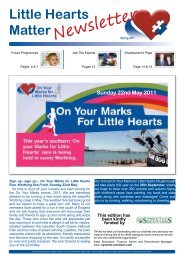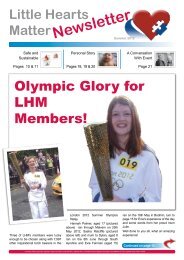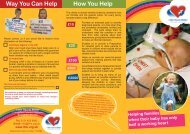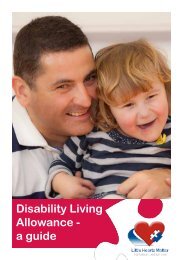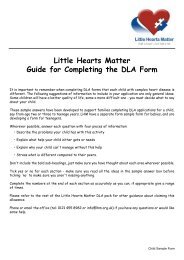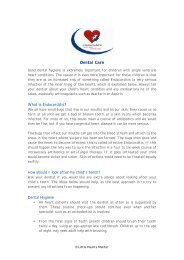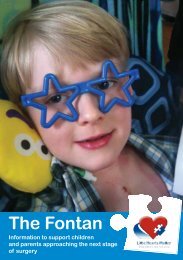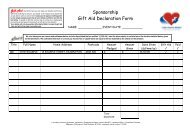here - Little Hearts Matter
here - Little Hearts Matter
here - Little Hearts Matter
- No tags were found...
You also want an ePaper? Increase the reach of your titles
YUMPU automatically turns print PDFs into web optimized ePapers that Google loves.
2122 LHEARTS 20PP:NewsletterNo2 2009.qxd 05/11/2009 10:06 Page 4MedicalThe article below looks at sport and exercise for children withsingle ventricle heart disease.Written byLynne KendallClinical Specialist Physiotherapist Congenital CardiologyLeeds General InfirmaryIs it safe for children and young people withsingle ventricle heart conditions to exercise?Absolutely Yes! T<strong>here</strong> are very few people who willbe advised not to do any exercise at all. Yourcardiologist will tell you what you can do and if t<strong>here</strong>is anything you are better to avoid. Everyone isdifferent so you must get individual advice aboutyour own heart problem.How much exercise?Everyone (yes that does mean you too) should tryto do regular physical activity. It may be that youhave symptoms, such as breathlessness, fromyour heart problem that limit the amount of activityyou can do, that is okay, just do what you can but atyour own pace and your own level.A really good guide to how much activity youshould do is the ‘Talk Test’, you should apply this toall activities/sports/play that you do. You shouldalways be able to talk when doing any activity evenwhen you are a bit ‘puffed’.If you have enough breath to sing then you needto put a bit more effort in, but if you are toobreathless to talk you need to STOP and RESTuntil you can speak again! You are much better tostop and rest BEFORE you get to this point thoughas it is not good for your heart to work so hard. Tryto learn to ‘pace’ yourself and recognise when youare exercising at the right level.Current public health guidelines for children 1 ,which apply to everyone including those peoplewith medical conditions, recommend a daily total of60 minutes moderate intensity physical activity onmost days of the week. Now, before you all yell ‘noway!!’ please read on:Y For children with single ventricle (or anycongenital heart disorder) the daily total of 60minutes can be ‘collected’ in 10-15 minuteperiods throughout the day if necessary.Y ‘Moderate intensity’ means enough to makeyou breathe harder (feel a bit ‘puffed’) and feelwarm, this may happen at quite a low level ofactivity but this is okay as long as it is morethan YOU normally do.Y ‘Most days’ means at least five times a week; itis very important to exercise regularly to feelthe benefits; now and again is just not goodenough!What kind of sports/activities are okay andwhat is it better to avoid?You probably need to think about the type ofsports/activity that you do, especially if you are a bitbreathless and/or are taking medicines such asWarfarin, because some activities are better thanothers for people with heart problems.How much you can do depends on your ownheart problem and how well your heart functionsduring exercise (your cardiologist can tell you moreabout this).It is important that you exercise but it is importantto stay safe too; this means choosing activities thatyou enjoy but maybe avoiding some things whichcould make your heart too tired.• It is usually better to avoid the really strenuousteam sports or competitions w<strong>here</strong> you have torace against other people as these will makeyour heart work too hard. For example,activities such as basketball, triathlon,competitive level swimming or cycling,distance running.• Sports w<strong>here</strong> you can get badly knocked orpushed over are generally not a good idea,especially if you take medicines such asWarfarin or if you have a pacemaker, forexample, hockey, rugby, football, judo.• If you have symptoms such as dizziness orfainting then avoid water-based activities;horse riding; motor sports; climbing etc w<strong>here</strong>a fall could be very harmful.It might help to think about what exercise involves:T<strong>here</strong> are two basic types of exercise calledisotonic and isometric. Most activities will involve abit of both but t<strong>here</strong> are some important points tothink about when choosing an activity/sport:1. Isotonic exercise (may also be called dynamicor cardiovascular exercise).This type of exercise includes things like swimming,cycling, walking and dancing. This type of exerciseis generally better for people with congenital heartproblems as long as you remember to always usethe ‘Talk Test’ as a guide to how much you can doand when to rest.2. Isometric exercise (may also be called static,weight or resistance exercise).This includes exercise often using weights and4REFERENCES1. NICE public health guidance Jan 2009;PH17Promoting physical activity for children andyoung people: www.nice.org.uk /PH172. Pelliccia A, Fagard R, Bjornstad HH,Anastassakis A, Arbustini E, Assanelli D,Biffi A, et al. (2005).Recommendations for competitive sportsparticipation in athletes with cardiovasculardisease: A consensus document from thestudy group of sports cardiology of theworking group of cardiac rehabilitation andexercise physiology and the working group ofmyocardial and pericardial diseases of theeuropean society of cardiology.European Heart Journal 26: 1422-1445.3. Hirth A, Reybrouck T, Bjarnason-Wehrens B, Lawrenz W, Hoffman A.(2006).Recommendations for participation incompetitive and leisure sports in patients withcongenital heart disease: a consensusdocument.European Journal of CardiovascularPrevention and Rehabilitation 13:293-299.4. Graham TP, Driscoll DJ, Gersony WM,Newburger JW, Rocchini A, Towbin JA.(2005). 36th Bethesda Conference:Eligibility recommendations for competitiveathletes with cardiovascular abnormalities.Task force 2: Congenital heart disease. JAm Coll Cardiol 45: 1326 - 1333.



